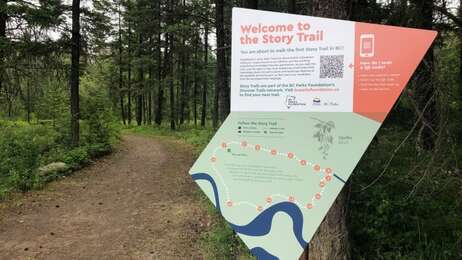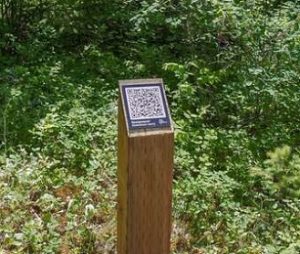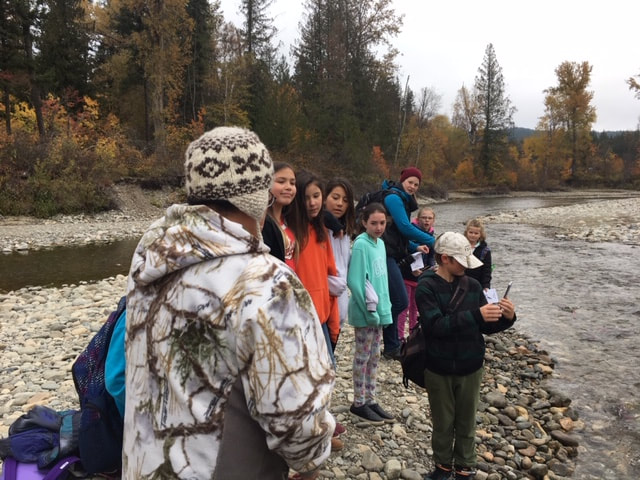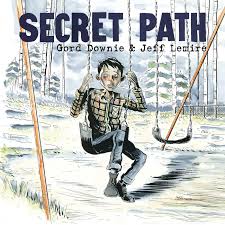Recommendation #1: Place Based Learning Using QR Codes and Student Voice
Place Based Learning and FPPL Place based learning can be described as the process of using the local environment as a starting point to teach across a variety of curricular areas. It encourages hands-on, real-world, and engaging learning experiences. This approach helps students develop stronger ties to their community and enhances appreciation of the natural world (Sobel, 2004). Students are able to experience their local heritage, culture, and landscapes when they are able to leave the classroom and participate in learning activities in their community. The connection between place based learning and traditional aboriginal ways of knowing are clear. Place based learning emphasises community, the natural environment, experiential learning, and a sense of place. These are all key components that are consistently woven throughout the First People’s Principles of Learning.
Example: Story Trail in Tsútswecw Park
Tsútswecw Provincial Park (formerly Roderick Haig Brown Provincial Park) is located on both sides of the world famous Adams River between Shuswap Lake and Adams Lake in the interior of British Columbia. This is also the traditional territory of the Secwépemc people. It is home to one of the largest sockeye salmon runs in the world. Every four years, during the “dominant run”, people from all over the world converge on the park to observe this spectacle of nature. The park has a large trail system that allows visitors to observe various portions of the river and its many estuaries.


Explore Story Trail in Tsútswecw Park and the interactive map within it for more information and to hear the student audio recordings that are connected to the QR codes on the story trail.
View the short video to the left for more detailed information about the story trail project.
- Learning ultimately supports the well-being of the self, the family, the community, the land, the spirits, and the ancestors
- Learning is holistic, reflexive, reflective, experiential, and relational (focused on connectedness, on reciprocal relationships, and a sense of place)
- Learning recognizes the role of indigenous knowledge
- Learning is embedded in memory, history, and story
Possible Connections to Curricular Competencies and the BC Curriculum (Students will be able to):
- Use Social Studies inquiry processes and skills to – ask questions; gather, interpret, and analyze ideas; and communicate findings and decisions (Social Studies 7)
- Assess the significance of people, places, events, or developments at particular times and places (Social Studies 7)
- Recognize how language constructs personal, social, and cultural identity (ELA 7)
- Recognize and appreciate the role of story, narrative, and oral tradition in expressing First Peoples perspectives, values, beliefs, and points of view (ELA 7)
- Apply First Peoples perspectives and knowledge, other ways of knowing, and local knowledge as sources of information (Science 7)
- Express and reflect on a variety of experiences and perspectives of place (Science 7)
- Identify and use appropriate tools, technologies, and materials for production (ADST 7)
What can educators do?
Learning opportunities and environments are all around us. They are not limited to the inside of our schools and classrooms. Much can be discovered by venturing into our communities to explore landscapes, people, language and community on a first hand basis. Student learning will inevitably be enriched as they experience places and develop their own unique artifacts to demonstrate their learning. Using technology for audio or video recordings can be a powerful tool to examine learning in the moment. QR codes allow these moments to be observed by others and can bring pieces of the outside environment into our schools.

What do educators need?
- Devices for recording student audio or video
- Software to create QR codes: Flipgrid, QR Code Generator, QR Code Monkey
- Locations in the community for student exploration
- Students, staff, parents, and community members to engage with the QR codes and observe student learning experiences
- Language teaching resource – First Voices
Recommendation #2: Digital Storytelling using Secret Path
Digital Storytelling and FPPL Digital storytelling can be described as the practice of using technological tools and multimedia to tell stories. Storytelling, in all its forms, can be an effective teaching method to motivate and engage students. It can improve student memory through reflection, interaction, and discussion (Hung, Hwang & Huang, 2012). It is a vital tool in creating valuable learning experiences for students. Transfer of knowledge through oral language and story is woven throughout the First People’s Principles of Learning. Core values such as connectedness, relationships, and respect for the environment evolve from the sharing of memories and stories (SetBC:Classroom Technologies and First Peoples Principles of Learning). Storytelling can be used to effectively bring to life many sensitive and controversial topics for students.
 Example: Secret Path and Residential Schools Secret Path is a multi media project depicting the life of Chanie Wenjack, a boy from the Marten Falls First Nation who died in 1966 after escaping from an Indian Residential School and attempting to walk 600 kilometers back to his home. It includes a musical album, a graphic novel, and a documentary film. The graphic novel and music was written by the late Gord Downie from the Canadian rock band The Tragically Hip. The project has been used by many Canadian schools to teach Indigenous history lessons. Secret Path can be a powerful tool in telling the story of the indian residential school system in Canada.
Example: Secret Path and Residential Schools Secret Path is a multi media project depicting the life of Chanie Wenjack, a boy from the Marten Falls First Nation who died in 1966 after escaping from an Indian Residential School and attempting to walk 600 kilometers back to his home. It includes a musical album, a graphic novel, and a documentary film. The graphic novel and music was written by the late Gord Downie from the Canadian rock band The Tragically Hip. The project has been used by many Canadian schools to teach Indigenous history lessons. Secret Path can be a powerful tool in telling the story of the indian residential school system in Canada. The Secret Path documentary video to the left is comprised of several components. It portrays the journey of The Tragically Hip’s Gord Downie to visit the family of Chanie Wenjack. It then tells the complete story through the music of Gord Downie and the illustrations of Jeff Lemire. It concludes with a panel discussion on the project and the role that it plays in working towards reconciliation.
- Brainstorming Activity – What are Stories?
- Learning Activity – The Ways to the Secret Path: Story Telling and Form
- Learning Activity – Listening to the Secret Path: Song Analysis
- Learning Activity – Reading the Secret Path: Graphic Novels
- Learning Activity – Writing about the Secret Path: Movie Review
- Learning Activity – Secret Path Language Activity: “The Stranger”
- Demonstration of Learning – Finding Your Own Secret Path: Story Telling and Self Expression
- Learning ultimately supports the well-being of the self, the family, the community, the land, the spirits, and the ancestors
- Learning is holistic, reflexive, reflective, experiential, and relational (focused on connectedness, on reciprocal relationships, and a sense of place)
- Learning recognizes the role of indigenous knowledge
- Learning is embedded in memory, history, and story
- Learning involves generational roles and responsibilities
- Learning requires exploration of one’s identity
Possible Connections to Curricular Competencies and the BC Curriculum (Students will be able to):
- Assess the significance of people, places, events, or developments at particular times and places (Social Studies 7)
- Make ethical judgements about past events, decisions, or actions, and assess the limitations of drawing direct lessons from the past (ethical judgement) (Social Studies 7)
- Apply appropriate strategies to comprehend written, oral, and visual texts, guide inquiry, and extend thinking (ELA 7)
- Think critically, creatively, and reflexively to explore ideas within, between, and beyond texts (ELA 7)
- Recognize how language constructs personal, social, and cultural identity (ELA 7)
- Use and experiment with oral storytelling processes (ELA 7)
- Recognize and appreciate the role of story, narrative, and oral tradition in expressing First Peoples perspectives, values, beliefs, and points of view (ELA 7)

Recommendation #3: Understanding ourselves through art
Identity & Art Storytelling, oral histories and artistic expression can play a significant role in understanding one’s origin and culture. In Indigenous culture, sometimes stories are told with symbolism so that abstract concepts or important events can be more easily understood or remembered. The importance of understanding one’s identity as a part of the learning process is one of the FPPL, and it is tied to the perspective that understanding who you are helps you understand your connection to others, to your culture, to the environment and to your actions (Alberta Education, 2009).
The process of creating art is very much a reflective and reflexive process. In many ways, artistic expression is innately tied to one’s identity and experience. Indigenous art is no different, which allows many of the FPPLs to fit naturally here.
Class discussion:
- What message and/or emotion the artists are trying to convey?
- What was the artist’s process of creation?
- What do the animals symbolize?
- What is the value of art?
Create a piece of art using an animal that best represents who you are. Write a description that explains how the image is a reflection of you. Here are some resources on animal symbology:
- Sketchbook, Sketchpad, for creating
- Sutori, padlet or Flipgrid for sharing
- Learning ultimately supports the well-being of the self, the family, the community, the land, the spirits, and the ancestors
- Learning is holistic, reflexive, reflective, experiential, and relational (focused on connectedness, on reciprocal relationships, and a sense of place)
- Learning recognizes the role of indigenous knowledge
- Learning is embedded in memory, history, and story
- Learning requires exploration of one’s identity
Possible Connections to Curricular Competencies in the BC Curriculum: Grade 9 Art
- Reflect on works of art and creative processes to make connections to personal learning and experiences
- Take creative risks to experience and express thoughts, emotions, and meaning
- Demonstrate respect for themselves, others, and the audience
- Collaborate through reciprocal relationships during the creative process
- Create personally meaningful artistic works that demonstrate an understanding and appreciation of social, cultural, environmental, and historical contexts
K-9 Art
- Demonstrate an understanding and appreciation of personal, social, cultural, historical, and environmental contexts in relation to the arts
- Explore relationships between identity, place, culture, society, and belonging through artistic experiences
Recommendation #4: Valuing the voices of experts
Science and FPPL Western knowledge tends to organize itself into content areas like arts and science, whereas Indigenous knowledge considers knowledge as holistically interconnected and cannot be separated into parts (Michell et al., 2008). Science is contextualized within the scientific method framework and the objective observer, while Indigenous knowledge uses symbols and stories to connect the understanding of the universe to the learner. These two perspectives may seem at odds, but they do not need to be approached as such. Science and FPPL both value inquiry, experiential learning, reflective thinking and the knowledge of experts. Finding opportunities to show both perspectives of knowledge will help students see that understanding can be formed from different ways of knowing.
width: 100%;
}
width: 100%;
}
- https://pnsn.org/outreach/native-american-stories/native-american-stories-overview
- https://www.washington.edu/news/2005/07/11/native-lore-tells-the-tale-theres-been-a-whole-lotta-shakin-goin-on/
- https://www.hakaimagazine.com/features/great-quake-and-great-drowning/
- https://pnsn.org/outreach/native-american-stories/dating-the-1700-cascadia-earthquake
- Environment and ecology are great starting points because it directly connects with the FPPL focus of relationships and sense of place.
- Take scientific concepts and connect them to the real-world applications or examples. Have students reflect on how this knowledge impacts them, the world around them or the future. Have them also consider what they can do to create positive change with this knowledge. I.e. What is my responsibility with this knowledge?
- Call on experts to share their knowledge or passion.
- Consider bringing in an elder to share with the class. Connect with a district aboriginal education department or contact a local First Nations friendship center or cultural center to connect with an ambassador or knowledge bearer. Be sensitive to cultural protocols.
- Skype-a-scientist helps teachers to connect with scientists who are happy to share the research they are working on
- When possible, use the place-based learning approach and get into the natural world. When this is not possible, supplement with videos and pictures to help students situate their learning and develop that sense of place.
- Learning ultimately supports the well-being of the self, the family, the community, the land, the spirits, and the ancestors
- Learning is holistic, reflexive, reflective, experiential, and relational (focused on connectedness, on reciprocal relationships, and a sense of place)
- Learning involves recognizing the consequences of one’s actions
- Learning recognizes the role of indigenous knowledge
- Learning is embedded in memory, history, and story
Possible Connections to Curricular Competencies in the BC Curriculum: Science 7-10
- Make observations aimed at identifying their own questions about the natural world
- Experience and interpret the local environment (also Sci K-6)
- Apply First People’s perspective and knowledge, other ways of knowing and local knowledge as sources of information(also Sci K-6)
- Seek patterns and connections in data from their own investigations and secondary sources
- Use scientific understandings to identify relationships and draw conclusions
- Consider social, ethical, and environmental implications of the finding from their own and others’ investigations
- Express and reflect on a variety of experiences and perspectives of place (also Sci K-6)